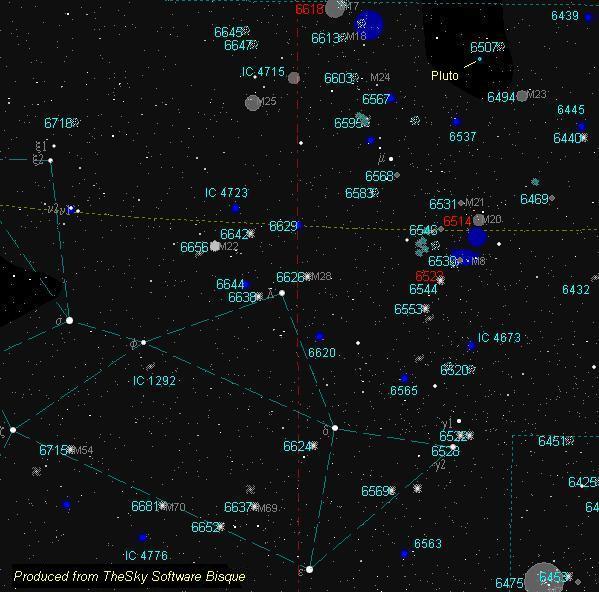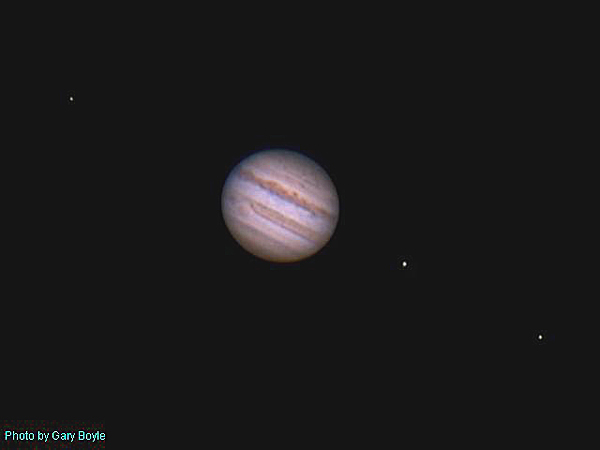The Teapot’s Starry Steam
September nights are ideal for cruising the Milky Way. As the nights get progressively longer and cooler (fewer mosquitoes), we can now spend more quality time with the sky above. On moonless nights – the mighty planet Jupiter is the first to greet us in the southeast within moments of sunset. Once you spot Jupiter, train your telescope on it. The background blue sky allows viewing of subtle detail without eyestrain. Once darkness sets in and the planet brightens to magnitude -2.8, filters are required to soften the overpowering bright image.
As our western sky transforms into darker pastels of orange and blue, we eagerly scan for the first dots of white. Leading the pack is Arcturus of the constellation Bootes down in the west, followed by Altair from Aquila the Eagle in the south and Vega, the brightest star in Lyra the Harp overhead. Like popcorn – more and more suns reveal themselves one at a time.
Within an hour of dusk, look due south for Sagittarius the Archer that actually appears as a Teapot. Imagine pouring a nightly cup of tea with the steam rising from the pot. This ghostly fog steadily raising all the way to Cassiopeia the Queen to the north is our home Galaxy. What you are seeing is the glow of literally millions of distant suns residing from tens to thousands of light-years away.
We start this month’s list with the brightest object in Sagittarius. M8, aka the Lagoon Nebula, is a superb magnitude 5.8 naked eye target. This emission nebula and is creating new stars in its ‘stellar nursery’. Taking up more area as the full moon, the Lagoon is located 5,200 light-years from us. An easy way to locate M8 from light polluted skies is to move six degrees north from the orange coloured giant Alnasl – the spout of the teapot. Close to the nebula is a cluster of recently developed stars. These young ones are probably a million years old.
Moving three lunar diameters north and a bit to the west we come to a dimmer object but never the less just as gorgeous – the Trifid Nebula. Catalogued as M20, it is a combination of emission and reflection nebula and is located 5,200 light-years. Taking on the appearance of a flower’s petal, dark lanes known as Barnard 85, break up the object into three sections.
To the northern edge, we come across another stellar nursery called the Swan or Omega Nebula. Designated as the 17th entry in Messier’s list M17 is located around 6,000 light-years away and 15 light-years in length. Some 35 very young energetic stars light up the nebula like a flashlight.

Aside from gaseous clouds, Sagittarius is also home to a fine selection of globular and open clusters. My personal favourite is M22. Taking a bit more room in the eyepiece that the full moon, a low to medium power ocular will reward you with nothing short than a stellar portrait. M22 is a well-defined splash of an estimated 70,000 suns of equal magnitude. The cluster is 10,400 light-years from us and thought to be 95 light-years wide. It will be difficult to take your eye off this magnitude 5.1 jewel of the night.
A very odd-looking pair of objects consists of the planetary nebula NGC 6818 and the irregular galaxy NGC 6822. Separated by 41 arc minutes, these two require investigation. NGC 6818 otherwise called the Little Gem Nebula will show filaments and structure, especially in photography. The parent star must have died off in layers. NGC 6818 is listed at magnitude 9.2 and is around 6,000 light-years from us.
| Object | Type | Magnitude | R.A. | Dec. |
|---|---|---|---|---|
| M8 | Planetary Nebula | 5.8 | 18h 03m | -24d 23' |
| M17 | Planetary Nebula | 6.0 | 18h 20m | -16d 11' |
| M20 | Planetary Nebula | 6.3 | 18h 02m | -23d 02' |
| M22 | Globular cluster | 5.1 | 18h 36m | -23d 54' |
| NGC 6818 | Galaxy | 10.0 | 19h 44m | -14d 09' |
| NGC 6822 |
Galaxy
|
9.0 | 19h 44m | -14d 48' |
| NGC 6835 |
Galaxy
|
12.5 | 19h 54m | -12d 34' |
| NGC 6836 |
Galaxy
|
13.0 | 19h 54m | -12d 41' |
NGC 6822 - Barnard’s Galaxy lies only 1.6 million lights years away and is considered as one of the closest galaxies to us. It is far from the conventional-looking spiral shape with arm and a bright nucleus. NGC 6822 is an irregular galaxy glowing at magnitude 9.2. The galaxy is peppered with active HII regions of star formation.
The northeast corner has a pair of galaxies We have NGC 6835 at magnitude 12.5 that is very elongated and measures 2.7 arc minutes in length. A little more than 7 arc minutes away, we come to NGC 6836, a 13th magnitude face-on galaxy that is only 1.2 arc minutes long. Before leaving Sagittarius, try looking for the now minor planet - Pluto.
If you have never been able to locate the planet Neptune, let Jupiter guide your way. Bluish-green Neptune is 5 degrees east of brilliant Jupiter. However, with Jupiter’s retrograde motion to the west, the distance between the two widens to 6.3 degrees. Nevertheless, fear not. The two a full moon’s width on December 21st.
Jupiter and more so the Jovian moons are putting on a great show. Astrophotographers are enjoying less atmospheric turbulence and the king of planets marches up the ecliptic. However, just like last month, the volcanic moon Io will cast a shadow on Europa on the nights of September 5th, 8th, 15th, 23rd and 30th visible from different parts of the continent and at different times. Check with the RASC Handbook for details.

The long-awaited ring crossing of Saturn is finally upon us. On September 4th the rings will have vanished only to seen the next day as the sunlight begins to illuminate the opposite side. Unfortunately, Saturn is very low on the horizon at sunset and dips below the horizon a mere 32 minutes after the sun has faded away. The two will be separated by only 11 degrees. The next ring crossing will be on the morning of March 23, 2025, with a separation of only 9 degrees.
The space shuttle Discovery is now docked with the International Space Station (ISS) and will be until Discovery’s scheduled landing for September 12th. You can watch the mission on your computer 24/7. The website even has a schedule of events. The ISS can be seen crossing your town or city. Find your area for predictions. Click on the date for a detailed star map.
The full Fruit Moon is on September 4th at 12:03 EDT and the fall equinox will occur on the 22nd at 17:18 EDT. After this date, nighttime hours are longer than daytime hours
Till next month, clear skies everyone.
